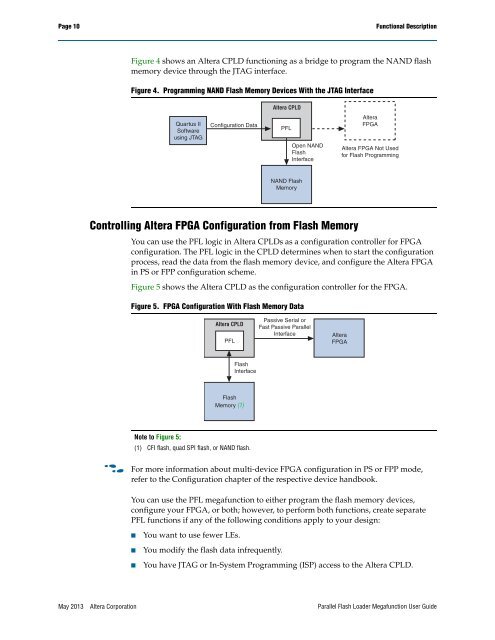Parallel Flash Loader Megafunction User Guide (PDF) - Altera
Parallel Flash Loader Megafunction User Guide (PDF) - Altera
Parallel Flash Loader Megafunction User Guide (PDF) - Altera
You also want an ePaper? Increase the reach of your titles
YUMPU automatically turns print PDFs into web optimized ePapers that Google loves.
Page 10<br />
Functional Description<br />
Figure 4 shows an <strong>Altera</strong> CPLD functioning as a bridge to program the NAND flash<br />
memory device through the JTAG interface.<br />
Figure 4. Programming NAND <strong>Flash</strong> Memory Devices With the JTAG Interface<br />
<strong>Altera</strong> CPLD<br />
Quartus II<br />
Software<br />
using JTAG<br />
Configuration Data<br />
PFL<br />
Open NAND<br />
<strong>Flash</strong><br />
Interface<br />
<strong>Altera</strong><br />
FPGA<br />
<strong>Altera</strong> FPGA Not Used<br />
for <strong>Flash</strong> Programming<br />
NAND <strong>Flash</strong><br />
Memory<br />
Controlling <strong>Altera</strong> FPGA Configuration from <strong>Flash</strong> Memory<br />
You can use the PFL logic in <strong>Altera</strong> CPLDs as a configuration controller for FPGA<br />
configuration. The PFL logic in the CPLD determines when to start the configuration<br />
process, read the data from the flash memory device, and configure the <strong>Altera</strong> FPGA<br />
in PS or FPP configuration scheme.<br />
Figure 5 shows the <strong>Altera</strong> CPLD as the configuration controller for the FPGA.<br />
Figure 5. FPGA Configuration With <strong>Flash</strong> Memory Data<br />
<strong>Altera</strong> CPLD<br />
PFL<br />
Passive Serial or<br />
Fast Passive <strong>Parallel</strong><br />
Interface<br />
<strong>Altera</strong><br />
FPGA<br />
<strong>Flash</strong><br />
Interface<br />
<strong>Flash</strong><br />
Memory (1)<br />
Note to Figure 5:<br />
(1) CFI flash, quad SPI flash, or NAND flash.<br />
f<br />
For more information about multi-device FPGA configuration in PS or FPP mode,<br />
refer to the Configuration chapter of the respective device handbook.<br />
You can use the PFL megafunction to either program the flash memory devices,<br />
configure your FPGA, or both; however, to perform both functions, create separate<br />
PFL functions if any of the following conditions apply to your design:<br />
■<br />
■<br />
■<br />
You want to use fewer LEs.<br />
You modify the flash data infrequently.<br />
You have JTAG or In-System Programming (ISP) access to the <strong>Altera</strong> CPLD.<br />
May 2013 <strong>Altera</strong> Corporation <strong>Parallel</strong> <strong>Flash</strong> <strong>Loader</strong> <strong>Megafunction</strong> <strong>User</strong> <strong>Guide</strong>
















